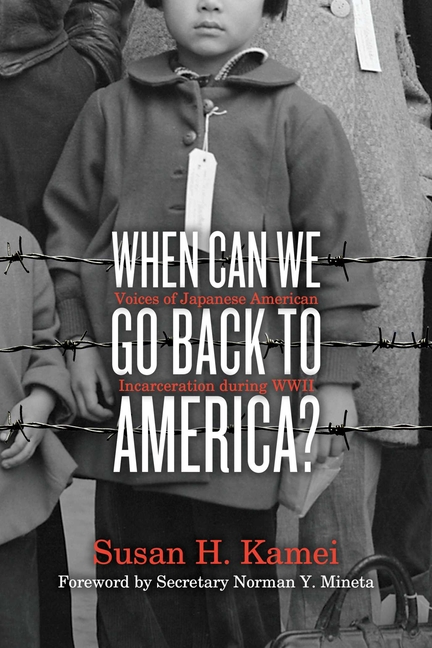Book Descriptions
for When Can We Go Back to America? by Susan H. Kamei
From Cooperative Children's Book Center (CCBC)
This comprehensive work about the incarceration of Nikkei (Japanese and Japanese Americans) during World War II explores the societal racism and political decision-making that fueled it, as well as its personal impact on thousands. The U.S. Justice Department and military had very different opinions regarding West Coast Nikkei after Pearl Harbor, while white farmers and business owners threatened by the success of their Nikkei counterparts saw opportunity. The military prevailed, leading to Executive Order 9066 ordering the incarceration of West Coast Japanese. Drawing on hundreds of interviews in primary and secondary source documents, the author includes numerous quotes from Japanese, Japanese Americans, and others in a work that looks at displacement and loss; rising tensions among Nikkei around the loyalty oath; the extraordinary accomplishments—and incredible losses—of the Japanese American units who fought in the war; and the courage of those who challenged aspects of Executive Order 9066 in the courts. Final chapters look at reparation efforts and Nikkei allyship with other communities in the wake of 9/11 and more recent immigration restrictions. The primary narrative comprises about half of this incredibly substantial book, while the voluminous end matter includes brief biographies of the many individuals who are quoted. There is also a timeline on the Japanese in America and detailed source notes for the author’s research. (Age 13 and older)
CCBC Choices 2022. © Cooperative Children's Book Center, Univ. of Wisconsin - Madison, 2022. Used with permission.
From the Publisher
In this dramatic and page-turning narrative history of Japanese Americans before, during, and after their World War II incarceration, Susan H. Kamei weaves the voices of over 130 individuals who lived through this tragic episode, most of them as young adults.
It’s difficult to believe it happened here, in the Land of the Free: After the bombing of Pearl Harbor in 1941, the United States government forcibly removed more than 120,000 persons of Japanese ancestry from the Pacific Coast and imprisoned them in desolate detention camps until the end of World War II just because of their race.
In what Secretary Norman Y. Mineta describes as a “landmark book,” he and others who lived through this harrowing experience tell the story of their incarceration and the long-term impact of this dark period in American history. For the first time, why and how these tragic events took place are interwoven with more than 130 individual voices of those who were unconstitutionally incarcerated, many of them children and young adults.
Now more than ever, their words will resonate with readers who are confronting questions about racial identity, immigration, and citizenship, and what it means to be an American.
It’s difficult to believe it happened here, in the Land of the Free: After the bombing of Pearl Harbor in 1941, the United States government forcibly removed more than 120,000 persons of Japanese ancestry from the Pacific Coast and imprisoned them in desolate detention camps until the end of World War II just because of their race.
In what Secretary Norman Y. Mineta describes as a “landmark book,” he and others who lived through this harrowing experience tell the story of their incarceration and the long-term impact of this dark period in American history. For the first time, why and how these tragic events took place are interwoven with more than 130 individual voices of those who were unconstitutionally incarcerated, many of them children and young adults.
Now more than ever, their words will resonate with readers who are confronting questions about racial identity, immigration, and citizenship, and what it means to be an American.
Publisher description retrieved from Google Books.


